Any SNAP household looking for additional information about their benefits should contact their local SNAP office.
The temporary boost to SNAP benefits put in place during the COVID-19 pandemic, known as emergency allotments, ended nationwide after the February 2023 issuance.
For additional support, contact USDA's Hunger Hotline 1-866-3-HUNGRY(1-866-348-6479).
The Hunger Hotline connects callers with emergency food providers in their community, government assistance programs, and various social services.
Questions & Answers
- Why are emergency allotments ending?
SNAP emergency allotments were a temporary strategy authorized by Congress to help low-income individuals and families deal with the hardships of the COVID-19 pandemic. The Consolidated Appropriations Act, 2023 law recently passed by Congress ends emergency allotments after the February 2023 issuance. This means by March 2023, all SNAP households’ benefits will return to normal amounts, without the added supplement.
- Will the end of emergency allotments impact my SNAP benefits?
SNAP benefits previously returned to normal amounts in 18 states and, therefore, will not be impacted by the recent law. This includes:
- Alaska, Arizona, Arkansas, Florida, Georgia, Idaho, Indiana, Iowa, Kentucky, Mississippi, Missouri, Montana, Nebraska, North Dakota, South Carolina, South Dakota, Tennessee, and Wyoming.
If you live in any of the other 32 states, DC, Guam, or the U.S. Virgin Islands, your benefits will return to normal amounts beginning with the March 2023 issuance.
- How much will my benefits change when emergency allotments end?
Emergency allotments allowed all SNAP households to receive an additional $95 in benefits or an additional benefit valued up to the maximum benefit for their household size, whichever value is greater. When emergency allotments end, you will return to your normal SNAP benefit amount which, depending on your household income, may be less than the maximum benefit for your household size. More information on how SNAP benefits are calculated can be found on our SNAP Eligibility webpage under “How much could I receive in SNAP benefits?”.
- How many households are impacted by the end of emergency allotments?
All SNAP households received a temporary boost in benefits due to emergency allotments, so all SNAP households have or will see a decrease to the SNAP benefits they receive when emergency allotments end. Some SNAP households already experienced that change; others will in February or March 2023.
- Are other pandemic-related SNAP waivers also ending, such as SNAP temporary student exemptions?
No, not at this time. Other SNAP waivers are expected to remain in effect until the end of the federal public health emergency, or PHE. More information is provided below:
- The suspension of the time limit for able-bodied adults without dependents, or ABAWDs, will end the month after the month in which the public health emergency declaration ends. When the time limit is reinstated, able-bodied adults ages 18-49 who do not have dependents and are not pregnant cannot receive SNAP benefits for more than 3 months within a 3-year period unless the individual meets certain work requirements or is otherwise exempt. The USDA Food and Nutrition Service has been working with state agencies to help them prepare for this transition. For more information on this requirement, visit work requirement policy resources.
- The SNAP temporary student exemptions that allowed certain students pursuing higher education at least half-time to be eligible to receive SNAP benefits, will be phased out starting 30 days after the federal PHE ends. Students enrolled at least half time in institutes of higher education may still be eligible for SNAP benefits if they meet a regular student exemption. For more information, view the End of Temporary Student Exemptions memo and visit our webpage about student eligibility.
- How does the Social Security Administration (SSA) cost of living adjustment (COLA) impact SNAP benefits?
Every year the Social Security Administration is required to make a cost-of-living adjustment to ensure the Social Security benefits keep up with inflation. Social Security is the most common source of income for SNAP households. When Social Security or any household income goes up, SNAP benefits may go down.
While SSA’s COLA impacts SNAP benefit amounts every year, the 2023 COLA is the largest in 40 years. Households that receive SNAP and Social Security benefits will see a decrease in their SNAP benefits as early as January 2023 because of a significant increase to their Social Security benefits to reflect the cost of living. However, the households will still experience a net gain, as the decrease in SNAP benefits is less than the increase in Social Security benefits.
- How much will my benefits change because of the Social Security adjustment?
The Social Security adjustment only impacts SNAP households that also receive Social Security benefits. The impact is not dollar for dollar. The Social Security adjustment is a net gain for SNAP recipients as it increased Social Security benefits more than it decreased SNAP benefits. However, some households will still experience a larger decrease to their SNAP benefits due to the end of emergency allotments occurring at or around the same time.
For additional information on your specific benefit amounts, contact your local SNAP office.
- When will the changes to SNAP benefits resulting from the Social Security adjustment occur?
The SSA COLA goes into effect Jan. 1, 2023. SNAP benefit amounts for households that also receive Social Security benefits will be impacted as soon as January (in states that already ended emergency allotments) and as late as March 2023 (in states and territories that are still providing emergency allotments).
If a household in a state or territory that is still providing emergency allotments is no longer eligible for SNAP benefits because of their increased income due to the Social Security adjustment, the household would stop receiving SNAP benefits as of January 2023.
- How many SNAP households are affected by Social Security COLA increases?
The latest available data (pre-pandemic) indicate that nearly half (47%) of SNAP households receive Social Security benefits. Most, but not necessarily all, of those households will see a change in their SNAP benefit amounts, as SNAP eligibility and benefits are based on many different factors. However, all impacted households will experience a net gain, as the adjustment increases Social Security benefits more than it decreases SNAP benefits.
- Will some households lose SNAP benefits because of the Social Security increase?
It is possible that some households may no longer receive SNAP benefits due to the Social Security increase if they are no longer income-eligible.
- Why does USDA treat Social Security as income for purposes of computing SNAP benefit eligibility and benefit amount determinations?
By law, all income (both earned and unearned) is included when determining SNAP eligibility and benefit amounts, unless explicitly excluded by statute. Social Security payments are not excluded under the law, so states must count them as income.
- Does SNAP adjust benefit amounts based on the cost of living as well?
Yes. FNS calculates cost-of-living adjustments for SNAP benefits each October. The most recent SNAP COLA adjustments are here: https://www.fns.usda.gov/snap/fy-2023-cola.
- Why does the SNAP COLA adjustment go into effect at a different time of the year than the Social Security COLA adjustment? To what extent do the COLA adjustments match?
FNS calculates cost-of-living adjustments for SNAP annually, like the Social Security Administration. However, when and how those calculations are done – and what impact they have – is set by law. SNAP’s COLA takes effect at the start of each FNS fiscal year (October) and impacts maximum benefit allotments, income, resource eligibility standards, and annual deductions.
Help Us Spread the Word
This collection of social media tiles can be used for Instagram and Twitter to assist our partners in communicating about the upcoming changes to SNAP benefits.
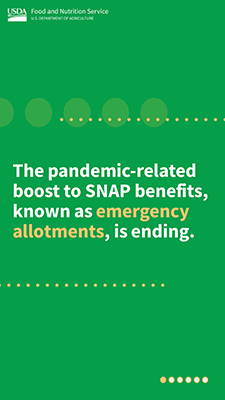
| 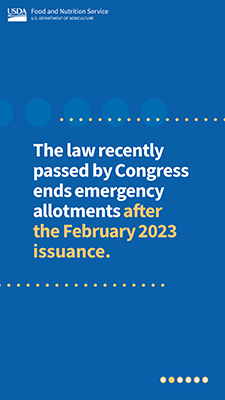
| 
| 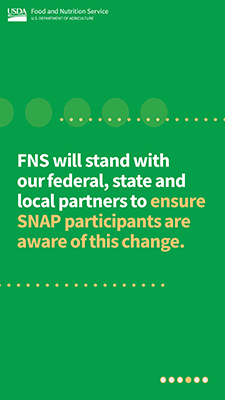
|

| 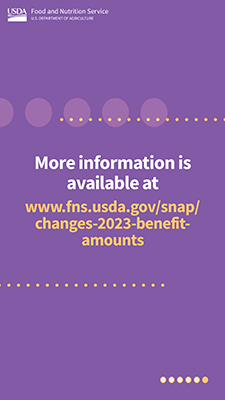
|

| 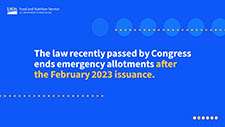
| 
| 
|

| 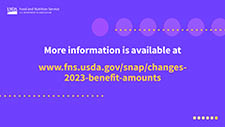
|

